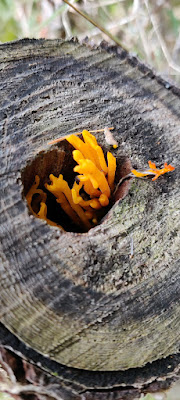The places have visited recently seem to be full of yellow flowers. There was a visit to a fantastic garden in Nethybridge and, more prosaically, exploring behind the Badenoch centre and looking at a cutting on the A9! But for a curious botanist/nature enthusiast there is always something to notice and learn from.
The garden in Nethybridge was open to raise money for charity, and it is always a pleasure to be able to explore someone else's garden and even better, there were cream teas...
 |
Peacock butterfly and a very tattered Tortoiseshell - correction - it's a Comma |
There were some large yellow flowers that the butterflies loved. The flower is Inula or Elecampane. The Peacock butterflies looked fresh and iridescent whereas the poor old tortoiseshell must have overwintered. UPDATE Thanks to Audrey for pointing out that it is not a tortoiseshell but a Comma.
Now for the less exciting visits. I had recorded the plants behind the Badenoch Centre in the Spring, but there was a Hypericum (St John's Wort) that I could not record because I needed to see the flowers to narrow it down to the species. It is finishing flowering right now so I was just in time.
It turned out to be Tutsan (
Hypericum androsaemum) which was a new find for me. The red fruits turn black (you can see some on the right hand side of the photo). Another yellow flower which is growing around the Badenoch Centre is Sticky Groundsel (
Senecio viscosus). It is a bit like Groundsel (
Senecio vulgaris) but is taller, has petals and is ... sticky.
Here are the two together for comparison:
 |
Sticky Groundsel on the left of each picture, and Groundsel on the right
|
The reason it is sticky is easier to see with some magnification The stem is coated with hairs which have blobs of sticky liquid on the ends.
.jpg) |
| The sticky hairs seem to have caught a few things |
The last visit was to the A9, a cutting where I have been before, but decided to revisit as parts of it have had new topsoil added, though I have no idea why. The slopes have been covered with yellow flowers for months. The older areas look brown as the flowers are now fruiting, but the newly topsoiled areas are bright yellow.
Nearly all the plants are crucifers - the cabbage family that has 4 petalled flowers. Much of it was oil seed Rape (Brassica napus) and Treacle mustard (Erysimum cheiranthoides)
These yellow crucifers are hard to tell apart unless you have both the flowers and the seed pods.
As a bit of relief from the relentless yellow flowers, now is a good time to see Devil's-bit Scabious (Succisa pratensis). It is mostly blue but can be found in shades of pink as well.
I have not quite finished with yellow things, but next time it will be a lichen!






































.jpg)




.jpg)



.jpg)
.jpg)

